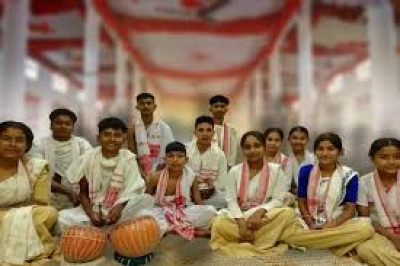Detailed Notes
During Dihanaam, participants use traditional instruments like the Negera, Taal, Khol, and hand-clapping to enhance the rhythm and spiritual atmosphere. Historically, the practice evolved from the strict recitation of ghosha-padas in namghars and satras, with designated leaders called namati or namlogowa guiding the verses. Over time, slight relaxations in these practices contributed to the formation of Dihanaam as a distinct musical and devotional style.
The cultural significance of Dihanaam is immense, serving as both a spiritual and social event. Large-scale performances, sometimes featuring thousands of participants, celebrate Assam’s rich heritage and unite communities in devotion. For instance, in January 2024, an attempt to break a world record saw 15,000 participants performing Dihanaam simultaneously in Sonapur, Guwahati. Future events are planned with even larger participation, highlighting the enduring popularity of this tradition.
Dihanaam is more than a musical ritual; it reflects Assam’s spiritual values, community bonding, and reverence for its saints. By combining melodic chanting with rhythmical instruments, it embodies both devotion and cultural pride. Modern efforts to preserve and popularize Dihanaam continue to inspire younger generations to engage with Assamese heritage, ensuring that this unique practice thrives for years to come.
FAQs with short answers
-
What is Dihanaam?A congregational prayer sung by women in Assam to praise Saint Sankardev.
-
Who performs Dihanaam?Traditionally performed by women, often in large community groups.
-
Which instruments are used in Dihanaam?Negera, Taal, Khol, and hand-clapping.
-
Where is Dihanaam usually performed?In satras, namghars, and community gatherings in Assam.
-
What scriptures inspire Dihanaam songs?Vaishnava texts like Kirtan-ghosa and ghosha-padas.
-
What is the call-and-response style in Dihanaam?Verses are sung by a leader and repeated or responded to by the group.
-
Has Dihanaam set any world records?Large-scale attempts have been made, e.g., 15,000 participants in 2024, but no official Guinness record yet.
-
What is the cultural significance of Dihanaam?It preserves Assamese heritage, fosters devotion, and strengthens community bonds.
-
Who leads the Dihanaam verses?Namati or Namlogowa, individuals with detailed knowledge of the ghosha-padas.
-
Why is Dihanaam important in Assam today?It connects modern generations with spiritual traditions and cultural identity.
